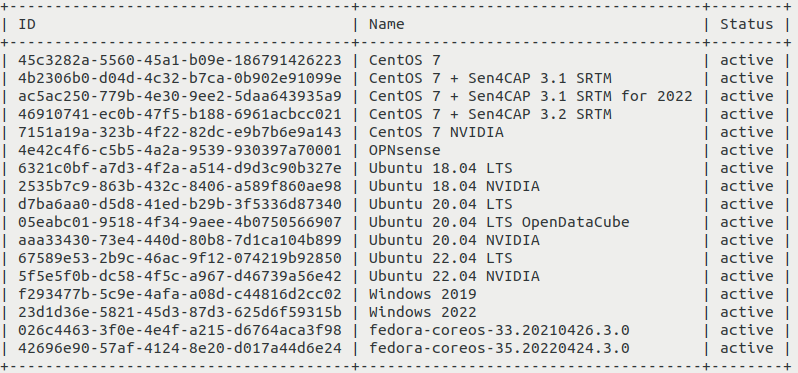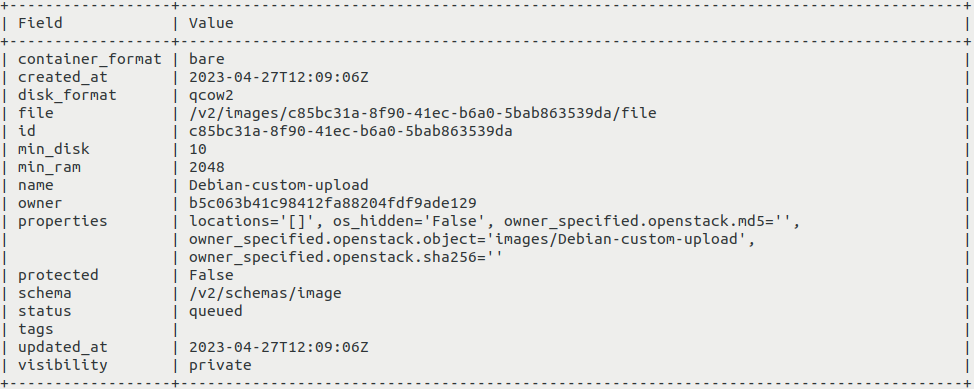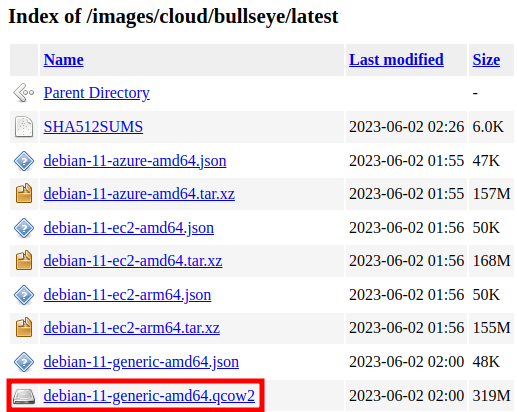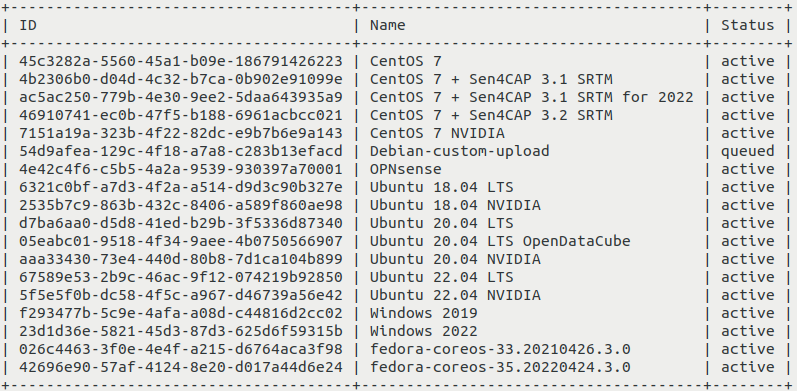How to upload your custom image using OpenStack CLI on CloudFerro Cloud
In this tutorial, you will upload custom image stored on your local computer to CloudFerro Cloud cloud, using the OpenStack CLI client. The uploaded image will be available within your project alongside default images from CloudFerro Cloud cloud and you will be able to create virtual machines using it.
What We Are Going To Cover
How to check for the presence of the image in your OpenStack cloud
How different images might behave
How to upload the image using only CLI commands
Example: how to upload image for Debian 11
What happens if you lose Internet connection during upload
Prerequisites
No. 1 Account
You need a CloudFerro Cloud hosting account with access to the Horizon interface: https://horizon.cloudferro.com/auth/login/?next=/.
No. 2 OpenStack CLI configured
You need to have the OpenStack CLI client configured and operational. See How to install OpenStackClient for Linux on CloudFerro Cloud. You can test whether your OpenStack CLI is properly activated by executing the openstack server list command mentioned in the end of that article - it should return the list of your virtual machines.
No. 3 Custom image you wish to upload
You need to have the image you wish to upload. It can be one of the following image formats:
aki
ami
ari
iso
qcow2
raw
vdi
vhd
vhdx
vmdk
The following container formats are supported:
aki
ami
ari
bare
docker
ova
ovf
For the explanation of these formats, see article What Image Formats are Available in OpenStack CloudFerro Cloud cloud.
No. 4 Uploaded public SSH key
If the image you wish to upload requires you to attach an SSH public key while creating the virtual machine, the key will need to be uploaded to CloudFerro Cloud cloud. One of these articles should help:
How to add SSH key from Horizon web console on CloudFerro Cloud
How to import SSH public key to OpenStack Horizon on CloudFerro Cloud
No. 5 Basic knowledge about the Linux command line
Basic knowledge about the Linux command line interface is required.
Always use the latest value of image id
From time to time, the default images of operating systems in the CloudFerro Cloud cloud are upgraded to the new versions. As a consequence, their image id will change. Let’s say that the image id for Ubuntu 20.04 LTS was 574fe1db-8099-4db4-a543-9e89526d20ae at the time of writing of this article. While working through the article, you would normally take the current value of image id, and would use it to replace 574fe1db-8099-4db4-a543-9e89526d20ae throughout the text.
Now, suppose you wanted to automate processes under OpenStack, perhaps using Heat, Terraform, Ansible or any other tool for OpenStack automation; if you use the value of 574fe1db-8099-4db4-a543-9e89526d20ae for image id, it would remain hardcoded and once this value gets changed during the upgrade, the automated process may stop to execute.
Warning
Make sure that your automation code is using the current value of an OS image id, not the hardcoded one.
Step 1: Check for the presence of the image in your OpenStack cloud
Before uploading an image you can check whether you need to do it - it may already be available on CloudFerro Cloud cloud. Assuming that you have met all of the prerequisites, including authenticating to the OpenStack CLI client, execute the following command:
openstack image list
You should see the list of images available to you, for example:

Step 2: Know the rules for the image before uploading it
Different images will behave differently on CloudFerro Cloud cloud, depending on how they are built.
- SSH access
If your image has SSH access enabled, you need to know what username to provide to access virtual machines created using that image. Most images will expect you to use SSH for access and will both
let you supply your own key-pair during the installation and
use it for access.
And yet, there are images which mandate the key pair to use and expect you to both
enter it during the installation and then
exclusively use it for access.
There also are images which work under completely different rules - they are outside of scope of this article.
- Web console access
Your image might have a default account which can be used to login to the web console. It might or might not have a password.
- Privileges
User accounts in the image might or might not have sudo privileges.
Here are the typical rules for default images from CloudFerro Cloud cloud:
- Account called eoconsole
You can login to this account via web console. First login will not require you to provide any password, but you will need to set a new password in order to access this account. It has sudo privileges.
- Account called eouser
This account can be accessed via SSH. You can authenticate to it using SSH key you provided during creation of your virtual machine. It also has sudo privileges. You will use this account in almost all applications within CloudFerro Cloud cloud.
This article How to access the VM from OpenStack console on CloudFerro Cloud explains how to enter the web console as eoconsole user and then continue using it as the eouser user. If custom image you uploaded supports web console access, you can use the web console mentioned in this article for that purpose. Please note, however, that the way of interacting with web console might be different.
By way of contrast, the rules to access the Debian image uploaded in this article (see below) are:
web console access is not allowed, so you have to use an SSH client from another machine
you can access the account called debian using SSH key you provided while creating your virtual machine
Step 3: Upload the image
Assuming you still want to upload the image, navigate to the folder which contains the image you wish to upload, for example:
cd ~/my-images
Execute the following command. Replace the parts of it as explained below.
openstack image create --disk-format qcow2 --container-format bare --private --file ./image.qcow2 --min-disk 6 --min-ram 2048 image_name --fit-width
The meaning of the parameters is as follows:
- --disk-format
Replace qcow2 with the image format - one of the following: aki, ami, ari, iso, ploop, qcow2, raw, vdi, vhd, vhdx, vmdk. If you do not specify this parameter, raw will be chosen.
- --container-format
Replace bare with the name of the image container format - one of the following: ami, ari, aki, bare, docker, ova, ovf. If you do not specify this parameter, bare will be chosen.
- --file
Replace ./image.qcow2 with the name and location of the image file.
- --min-disk
Replace 6 with the chosen storage requirements in gigabytes - for example, leave 6 if you wish to use that image only on virtual drives that have no less than 6 GB.
- --min-ram
Replace 2048 with the RAM requirement for your operating system in megabytes - it will prevent creation of VMs with insufficient RAM
- Image name
The last parameter is the name under which you wish your image to be known by OpenStack. It does not have to be the same as the name of the file you are uploading. To set it up, replace image_name in the command above.
Visibility rules
Visibility of the image defines which projects can access the new image. You can set it in one of the following ways:
private makes the image visible within your project. It can be set by passing --private parameter to the above command.
shared makes the image visible within your project and shareable with other projects. It can be set by passing --shared parameter to the above command.
Please note, that these parameters:
receive no input parameters,
you can choose only one of them at any time and
if you do not add any of these parameters, it will set visibility to private.
Images with the visibility status set up to public can be seen by all users of the cloud. This privilege is reserved only for the administrators of the CloudFerro Cloud cloud as a whole.
Administrators within their own organizations also cannot use --public and it goes without saying that, if a standard user tried to upload this type of image, the process would also result in an error.
- --fit-width
Optional parameter which improves the legibility of the output in some circumstances. It attempts to fit the width of the output to the width of the display and can be used with many OpenStack commands.
After executing the command above, the upload process will begin. No output should be displayed until it is finished.
If you lose Internet connection during the upload and reconnect again, the process might get resumed. In that case, the image should still be successfully uploaded. However, if you are unsuccessful at that, you will need to delete the failed upload and try again. Please see the section Troubleshooting - Deleting incorrectly uploaded images in the end of this article.
Once the process is over, the output should contain information about the uploaded image, including its ID in field id. It will be similar to this:

The steps now are:
copy the ID,
replace c85bc31a-8f90-41ec-b6a0-5bab863539da with the ID you copied in the command below and execute it
openstack image show c85bc31a-8f90-41ec-b6a0-5bab863539da --fit-width
Make sure that the field status of the upload contains active or saving. If it is not, that means that the image was likely incorrectly uploaded. You should delete that image and try again. For more information, please see the section Troubleshooting - Deleting incorrectly uploaded images in the end of the article.
If the status of your image is saving, execute the command mentioned above again until it is active.
If your image is in the Saving status for too long, it could mean that something went wrong. Please contact CloudFerro Cloud customer support in this case: Helpdesk and Support.
Example: How to upload image for Debian 11
This example covers uploading the official QCOW2 image for Debian 11 which is not available on CloudFerro Cloud cloud by default.
First, navigate to https://cloud.debian.org/images/cloud/bullseye/latest/ and download the image debian-11-generic-amd64.qcow2 to your computer:

Open the terminal in which you have access to the OpenStack CLI and use command source with the appropriate RC file as the parameter, as you did in Prerequisite No. 2.
Navigate to the folder containing that image. Execute the following command:
openstack image create --disk-format qcow2 --container-format bare --private --file ./debian-11-generic-amd64.qcow2 --min-disk 10 --min-ram 2048 Debian-custom-upload --fit-width
It should upload the image under the name Debian-custom-upload with the visibility set to private. The requirements for that image will be set to 10 GB minimum storage and 2 GB RAM - you can, of course, provide the values of your choice here. If you want to set the visibility to shared, replace the –private parameter with the –shared parameter.
During the upload process, you should see no output. Once the process is complete, the output should change to this:

To make sure that the upload was successful, copy the ID of the image which can be seen in the id field. In the command below, we use c85bc31a-8f90-41ec-b6a0-5bab863539da and you need to replace it with the ID of the image you copied:
openstack image show c85bc31a-8f90-41ec-b6a0-5bab863539da --fit-width
Make sure that the field status contains active:

Execute the following command to see the images available to you again:
openstack image list
You should now see your image on the list.

Troubleshooting - Internet connection lost
If you lose Internet connection during image upload, the process will be resumed automatically if reconnected in timely manner. Then, after the upload, you will receive the output similar to the one below:

You can verify its status by executing the command below. In it, replace c85bc31a-8f90-41ec-b6a0-5bab863539da with the ID of your image copied.
openstack image show c85bc31a-8f90-41ec-b6a0-5bab863539da
If the status is active, you should be able to create a virtual machine using that image.
Sometimes, however, the upload will not be successful. The openstack image list command will then show that the image has still the status queued, which means that the upload is still in a queue, waiting to be uploaded:

You will then need to delete that image and try uploading it again. To do it, first copy the ID of the image from the output of the command above. After that, execute the command below. In it, replace 54d9afea-129c-4f18-a7a8-c283b13efacd with the ID of the image you copied:
openstack image delete 54d9afea-129c-4f18-a7a8-c283b13efacd
After that, you can try uploading again.
What To Do Next
You can also upload images using the Horizon dashboard: How to upload custom image to CloudFerro Cloud cloud using OpenStack Horizon dashboard.